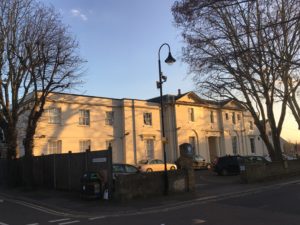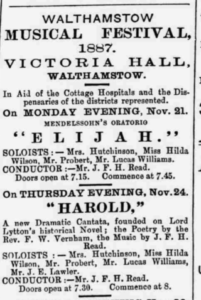Ten years on from qualifying as a City of Westminster Guide I wouldn’t have imagined that one of my most successful walks would be in Walthamstow. I’m sure that many of my social media followers are beginning to despair that I will ever do a walk again that’s not in this area.*
I started leading walks in Walthamstow back in 2012 as part of the Appetite Festival which was organised by the same people who organise the excellent E17 Art Trail (2019 details here). Since then my Walthamstow walk has changed substantially and to be honest changes each time I do it as I find out something new. My research now is an ongoing (and rather obsessive) process. I am currently spending rather a lot of time researching one of the many occupants of the house in the picture below and at some point in the future this will probably be written about in another blog post.

Orford House
When I started guiding I confess that I probably didn’t know each area in detail but now see the error of my ways. It would however be impossible to know the full history of any area and researching for the walk I am doing this Saturday 30th March as part of Walthamstow Notes has introduced me to a side of the area I had never considered before – Walthamstow’s musical heritage in the period after the arrival of the railways.
On my regular ‘From Monoux and Morris to Beer and Bacon Jam’ walk I explain that the arrival of the railways with the accompanying cheap workmen’s fares was a catalyst for a lot of the rich people moving out. Edward Lloyd whose children bequeathed what is now the William Morris Gallery and the surrounding park to the people of Walthamstow moved his family to Westminster in 1885. He believed there wouldn’t be enough suitable companions for his growing family. William Morris himself was also quite scathing about Walthamstow. In a letter of 1883 Morris said the area was “… once a pleasant place enough but now terribly cocknified and choked up by the jerry builder”.
Having said that going back further into the history of Walthamstow there are many rich people who wanted to help the less fortunate of the area – George Monoux being the most famous one but there are many other benefactors who left money to improve the lives of the poor.
Then I was introduced to John Francis Holcombe Read, a composer whose name already existed in my notes as he had built the Victoria Hall which was on the site of what is now Mirth Marvel and Maud. He spent his own money to build this hall partly so his composition ‘Harold’ could be performed!

The Chelmsford Chronicle, 11th November 1887. Image © THE BRITISH LIBRARY BOARD. ALL RIGHTS RESERVED. https://www.britishnewspaperarchive.co.uk/
Here was a man who had moved to Walthamstow after the arrival of the railways. He had made several fortunes as a City stockbroker but he was very much involved in music too being a musician and composer. Much of the money he had made in the City was spent in Walthamstow improving the cultural lives of the residents. When I started digging deeper I found he was connected to many cultural societies in Walthamstow and further afield. If you know where to look his name is everywhere!
To find out more about Mr J F H Read as he is more commonly known and the Walthamstow of his time why not come along on my walk this Saturday 30th March. Tickets are free this time but please book as I do have to put a limit on numbers. As mentioned above this is part of Walthamstow Notes a day of free music and talks taking place both at Read’s former house, Chestnuts House and Vestry House Museum.
The walk starts from Chestnuts House at 398 Hoe Street but do please book your place in advance via this link
* I do have a couple of walks outside Waltham Forest coming up – A Drinking History of Clerkenwell on both Tuesday 2nd April and Easter Monday 22nd April. Details of these and all my upcoming walks can be found here

0 Comments